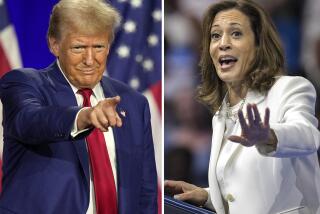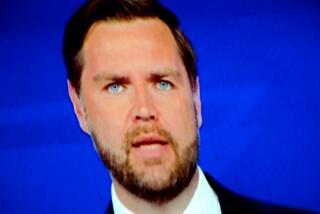It’s the Spin, Not the Debate
- Share via
Yes, the Thursday night debate will be critically important to John Kerry and George W. Bush. Polls indicate that 60% to 84% of the electorate will watch all or part of it. And yes, the candidates are right to be feverishly studying, memorizing and rehearsing for their 90-minute encounter. But the real question is not how many tens of millions of people tune in, and it’s not necessarily how well the candidates perform either. The real question is what happens in the moments, hours and days after the debate is over.
Why do I say that? Four years ago, instant polls conducted by the media after the first debate between then-Texas Gov. Bush and Vice President Al Gore showed a narrow Gore advantage. Furthermore, respondents indicated in these initial measurements (taken among 500 people over the telephone in the 30 minutes after the debate ended) that the debates had almost no effect on their choice for president. Those who were for Bush before the debates remained in support of him immediately after. The same was true for Gore’s supporters.
Yet, within a week (a week during which not much else of substance happened in the campaign), Bush had gained 8 percentage points. In addition, polls showed that the American people had changed their minds and were now convinced that Bush, not Gore, had won the encounter.
How did this happen?
The Bush campaign had persuaded the media, and hence the American people, that the vice president was overbearing and presumptuous in his manner during the debate. And so even though some people had initially said Gore offered more elaborate answers during the debate, by a week after the encounter, the tide of public perception had shifted and Bush was believed to have won. With that belief came a significant narrowing of Gore’s margin in national polls.
Both sides this year will try to accomplish what Bush and his advisors did four years ago. The debate format offers little chance for interplay between the two candidates, suggesting that the American people are likely to see rehearsed answers to anticipated questions -- questions that each candidate has answered time and again.
So each campaign’s real work will begin immediately after the debate, as both sides work to provide reporters with documentary evidence that the other side made mistakes, flipped-flopped and offered answers that were lacking in depth and specificity.
The candidates’ surrogates and operatives will try to draw the media’s attention to scripted sound bites each candidate has delivered in the hope that reporters and commentators will treat these comments as representative of what really happened and was most important in the debate.
The hope is that like Ronald Reagan’s “there you go again” line in 1980, one comment will become the prism through which voters come to view the entire confrontation.
Close to half a billion dollars will be spent trying to influence voters during October and early November. There is certain to be a deluge of television ads, direct mail, phone calls, partisan speeches and rallies.
However, all this money and effort is likely to be less important than how the two candidates and their surrogates handle the 48 to 72 hours following the first debate. Tune in both before and after the confrontation to get a very clear sense of what is likely to be the result on Nov. 2.
More to Read
Get the L.A. Times Politics newsletter
Deeply reported insights into legislation, politics and policy from Sacramento, Washington and beyond. In your inbox three times per week.
You may occasionally receive promotional content from the Los Angeles Times.










